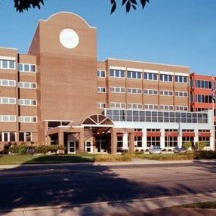
Both Providence and Atlanta Medical served majority Black, urban neighborhoods. Hammond, Indiana, sandwiched between Chicago and Gary, Indiana, has seen its White Non-Hispanic population plunge from 67% in 1990 to 37 percent in 2020. With a darker population, it is experiencing the closure of Franciscan Hospital, which has served Hammond and many of Chicago’s blackening south suburbs for more than 120 years.
So, how is the heart of Northlake Methodist Hospital, in 80 percent Black Gary (population 70,000), still beating?
Urban hospitals are not alone. Across the U.S., 892 hospitals — more than 40 percent of all rural hospitals in the country — are either at immediate or high risk of closure according to a report from the Center for Healthcare Quality and Payment Reform.
So, how is the heart of Northlake Methodist Hospital, in 80 percent Black Gary (population 70,000), still beating?
"There will always be a hospital in Gary," said Ray Grady, president and CEO of Methodist Hospitals in an interview with the Northwest Indiana Times. "This is not a community we're going to abandon. It's an integral part of our mission. It's where our hospital was born. We have a unique commitment to this community."
Along with Grady’s commitment is a legal agreement that would make abandoning The Steel City a challenge. The agreement is the result of a suit filed in the 1970s by then-Mayor Richard Hatcher and others.
As one of two of the nation’s first Black mayors of a major American city, Hatcher witnessed what others would experience later. His administration and others sued the hospital after it began transferring services to its newer Southlake campus in Merrillville, a town created to the south of Gary with the help of the state of Indiana as Whites fled Gary after Hatcher’s historic 1967 election.
The federal consent decree requires Methodist to provide equal services at both hospital campuses. The U.S. Office of Civil Rights has to approve any investments in either health center.
Dr. Garfield Clunie, President of the National Medical Association, America's oldest and largest organization of African American physicians, says it is difficult to fight a hospital’s decision to close a hospital once the owners remove resources from an often less-privileged hospital to another. The tactic, he says, eventually denies the more challenged hospital services and the income those services generate. He added that, “when you take away the services, that is what creates the problem.”
Hammond Mayor Tom McDermott, who is White, concluded, “ . . . it underscores the problem in America—an America that now has two healthcare systems—one if you are wealthy and one if you are not."
Grady has said that of the 37 potential suitors for a merger, only Franciscan was willing to even honor the spirit of the consent decree. Gary leaders eventually agreed with modifications. Nevertheless, the negotiations failed.
Franciscan now plans to cease inpatient care and emergency room services at their hospital in Hammond, a city that has experienced an influx of new Black residents, largely from Illinois, and Hispanics. The nonprofit hospital chain plans to direct patients to its hospitals more than six miles south in wealthier, Whiter Munster and Dyer, Indiana. (Munster, population 24,000 has two hospitals. Dyer, population 16,000, has one hospital).
Aside from the consent decree, national and state polices also keep Methodist Hospital’s Northlake campus in Gary open.
Because of the population it serves, Methodist gets about three-fourths of its gross revenue from government payors. Indiana is one of 33 states that expanded Medicaid under Obamacare, which decrease the number of non-paying patients Methodist serves.
"Obamacare has been a positive," continued Clunie, who practices at New York University-Lagone Health in New York City. “Obamacare was created so there can be an increase in affordable insurance so people in the lower income status can afford care and bring revenue to hospitals in their local areas,” he explained.
The downtown Gary hospital also receives $50 million a year of "disproportionate share" payments from the federal government because it serves a large percentage of low-income patients.
State policies also help keep the Gary hospital afloat. Indiana distributes its Medicaid funding essentially on a "sliding scale," as with the state giving a higher percentage of the government money to the hospitals that serve the greatest share of indigent patients.
Government and private policies affect which people receive health care, a fact that has come home to many communities including Hammond. Regarding the closing of Franciscan, Mayor Tom McDermott, who is White, concluded, “This announcement has left Lake County’s largest city without a hospital for its 80,000 residents and it underscores the problem in America—an America that now has two healthcare systems—one if you are wealthy and one if you are not."






